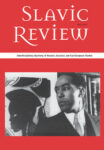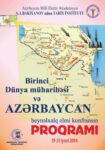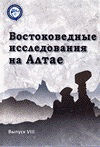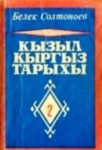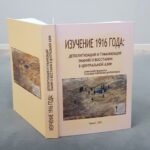
Study of 1916: Depoliticizing and Humanizing Knowledge of the Rebellion in Central Asia / Editors: Alexander Morrison, Gulnara Aitpaeva – Bishkek: Maxprint. – 2020.- 448 p
This collection of conference materials devoted to the theme of 1916 in Turkestan. Being organized by the “Aigine” Cultural Research center under the leadership of Professor Gulnara Aitpayeva, the event was held in Karakol on May 31-June 1, 2019.
This event was organized in one of the “hot spots” of century-old events. The conference was interesting and productive, there were lively discussions in the course of the sessions and plenary session.
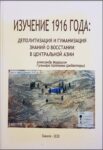 Researchers from different countries of Central Asia presented reports on the topic of the event, in addition, guests from far abroad also participated in the conference. We provide below the abstracts from the book.
Researchers from different countries of Central Asia presented reports on the topic of the event, in addition, guests from far abroad also participated in the conference. We provide below the abstracts from the book.
READ OR DOWNLOAD THE BOOK in Russian with the overview in English
We – Vladimir Schwartz and Asel Daniyarova – took part in this scientific forum on behalf of the Sanzharbek Daniyarov Foundation at the invitation of Aigine. Organizers offered Vladimir Schwartz the opportunity to deliver a plenary report, after which the speaker from the audience received questions and made comments.
When preparing the conference materials for publication, the reviewers did not fully agree with our point of view, at the same time, we did not find it possible to accept all the reviewers’ comments. In this regard, the editors included into the Collection both our articles and the comments of reviewers – Tomohiko Uyama and Aminat Chokubaeva. In our opinion, such an unconventional decision by editors Alexander Morrison and Gulnara Aitpayeva makes the collection even more interesting and informative, gives ground for further reflection and research.
————————-
The book is available only in Russian with editors’ introdution and abstacts in English (the link to the full pdf is above).
ABSTRACTS
Asel Daniyarova Changing Perspectives on the Behaviour Patterns of the Kyrgyz Patrilineages’ Leaders in 1916 According to Newly Discovered Facts
The article focuses on the behaviour patterns of manaps, the leaders of the Kyrgyz patrilineages (uruu), during the events of 1916 known as the Ürkün in Semirech’e. The analysis of these patterns in the light of newly discovered facts shows the patterns of rapid change named here as “realizing the inevitable” (osoznanie neizbezhnogo). There are three conditional stages of the transformation suggested: shock, confusion, decisions taken following implementation, and Ürkün – the exodus from the homeland. The seven manaps’ cases are compared to draw a correlation between their actions and the assessment of these acts given in various school-books, monographs, and media published during the last hundred years. The assessments vary fundamentally depending on changing political situations and relevant ideologies.
Aminat Chokobaeva The Role of Manaps in the 1916 Uprising: on Asel Daniyarova’s article on “Changing Perspectives on the Behaviour Patterns of the Kyrgyz Patrilineages’ Leaders in 1916 According to Newly Discovered Facts”
Daniyarova’s article on “Changing perspectives on the behaviour patterns of the Kyrgyz patrilineages’ leaders in 1916 according to newly discovered facts” shows that, during the uprising of 1916, manaps were guided by the tasks of preserving their clans. At the same time, Daniyarova argues that manaps were forced to lead the uprising by the incendiary actions of the authorities. This article is an attempt to reconsider some of the arguments made by Daniyarova on the basis of archival documents.
Askar Dzhumashev The 1916 Uprising in the Lower Amu-Darya: Nature and Features
The article studies one of the complex but vivid moments of the 1916 Uprising taken place in the lower Amu-Darya. Based on factual material, the author elaborates on the social and economic position of Kara-Kalpaks as divided between the two states. He compares the factors of the Uprising in Khiva and Amu-Darya showing similarities and differences of the events. Bakhtiyor Alimdzhanov The Economic Life of the ‘Indigenous’ (korennoi) Turkestan and the 1916 Events The article examines the sources of the Russian Empire’s economic policy in Russian Turkestan. For it, the author studies particularly the role of commercial banks in the life of local populations. A special place is given to the economic relations and prices’ increase during the First World War, as well as to the influence of economic processes on the 1916 events.
Dzhamilia Madzhun (Musarova) International Relations and Foreign Participation in the 1916 Events in Semirech’e
A number of the Tsarist officials in Semirech’e surmised the foreign agents’ organizing role of the Uprising that exploded Turkestan in 1916. In contrast, Russian and Kazakh intellectuals did not see any foreign influences in the events. They made clear instead that the Uprising was caused by the ruthless greed of the representatives of the colonial power, Cossacks, and some of the Slavic settlers. The article answers the question: whether external factors had any actual influence during the 1916 Uprising, or did it rather have a fictional character?
Dzhanyl Bokontaeva The Oral History of the 1916 Uprising: Memories from Issyk-Kul Province
The paper deals with the perception of the remembered experience and construction of the memories about the 1916 Uprising based on the oral history collected in the Issyk-Kul province. The focus is given to the traumatic memory of the ҚrkҚn when people fled to China over the impassable mountain passes, and the victims, about life difficulties in China, as well as about the survivors’ return to the homeland.
Gulzada Abdalieva “The Woeful Blood Flows in Our Veins”: The Three Ürkün in the Kyrgyz Memory
This article examines the traumatic memory of the three Ürküns the Kyrgyz of China share. Analysing the field data collected in China among the Kyrgyz where they had to migrate, the main focus is on the forms of memory formation about their forced migration. Inomdzhon Mamadaliev The Social Conflict of 1916 in Khujand: A Retrospective View on the Relations of Power and People The article scrutinises step by step all the conflict events (called here ‘uprisings’) of a social character along with their preconditions and reasons from 1871 to 1916. What is important is the new archival data that shed light on some of forgotten and ignored moments. Building on the national concept of historical writing, the author then suggests a new approach to understanding to the colonial politics of the Russian Empire to its Central Asian territory. With this, author aims to understand the nature and content of the antecedent events building the soil of the social conflict of 1916.
Ivan Fukalov The Power Legitimacy and Its Aspects: The 1916 Uprising Leadership
The paper studies the process of legitimation of the 1916 Uprising leadership, its aspects and specifics. For it, a brief history is provided focusing on the power development of the leaders of local patrilineages (uruu), their functions, and main activities. The 1916 Uprising is also considered in comparative perspective with the other uprisings that happened almost simultaneously in the other regions under different circumstances. A special focus is made on the specific forms of power legitimization, and the arming of the insurgents, as well as on the external forces’ influence on these forms of power. The role of power symbols, such as the oaths and flags, of the Uprising leaders will be also considered.
Karylgash Bizhigitova The ‘Voices’ of Ordinary Participants and Eyewitnesses of the 1916 Uprising: The Case of the Zhayilmyshevsk District in Semirech’e Province (Modern Kazakhstan)
The article analyses the large archival document on the 1916 events on the Zhayilmyshevsk district of the Vernyi district in the Semirech’e province (the current territory of Karasay district in the Almaty province, Kazakhstan). As result, the author shows that local people were not ordinary ‘voiceless’ participants and eyewitnesses of the 1916 events. Instead, their ‘voices’ had significantly influenced the decisions of the representatives of the colonial power, including the judicial officials. Furthermore, these ‘voices’ contributed to the following construction of the events by the colonial administration, and then by the Soviet and post-Soviet scholars.
Maisara Bekmagambetova Legitimation of A. Zhanbosynov’s Leadership During the 1916 Events in Torgay Province (Modern Kazakhstan)
The Torgay province was one of the centres of the 1916 events. Within the Soviet historiography and due to Marxist ideology, the myth of Amangeldy Imanov’s exclusive leadership was established. However, as this article explains, there are facts found in favour of another leader, Abdulghafar Zhanbosynov. His social and political status, as well as his moral and charismatic characteristics, reinforced the legitimation of his position as one of the core leaders of the 1916 Uprising. Murat Imankulov Once Again on the Losses in the Period of the Uprising of 1916 in Kyrgyzstan One of the most controversial and sensitive aspects of scholarship on the uprising of 1916 remains the issue of human losses among the native population of Central Asia. The exact number who perished during the suppression of the uprising is still unknown. At the same time, the presence of demographic and statistical data collected before and after the uprising of 1916 gives us an opportunity to estimate an approximate decrease of the native population, including the deceased as the result of the uprising, its suppression and the flight of the nomadic population to China. This article attempts to establish the decrease of the Kyrgyz population of the Semirech’e oblast on the basis of statistical data of the late 19th and early 20th centuries and to reveal the flaws in the calculation methods used by some scholars.
Nabidzhon Rakhimov Khodimi Dzhamolak: Myth or Reality?
The 1916 Uprising in Khujand became the first political event involving the Tajik women. Khodimi Dzhamolak has become the embodiment of the image of the female rebel, however, archival data on her is missing. Her image was glorified according to the strengthened Soviet ideology directed to the construction of the image of a woman fighting for her political rights and gender equality.
Oybek Mahmudov The Islamic Factor and ‘Clergy’ in the 1916 Events in Turkestan:
The Perspective of the Russian Tsarist Officials The article studies the perspectives of the Russian Tsarist officials on the role of the Islamic factor and the Muslim ‘clergy’ in the 1916 events in Turkestan. Based on the published and unpublished archival documents (such as reports and dispatches), the article reproduces the officials’ representations and visions on the local populations whom they called tuzemtsy. The analysis aims to better comprehension of the decision-making mechanism of the Russian officials that led to the tragic events in 1916.
Tomohiko Uyama The Conspiracy Theory Obstructs an Understanding of the Question’s Essence: On the Article ‘The Highest Order of 25th June 1916:
The dual-purpose document” Whilst some authors reflect on the conspiracy theory of external powers, V. Schwartz puts forward a conspiracy theory of the Resettlement Department of the Russian Ministry of Agriculture. The main document that Schwartz builds his argument on is interesting, however, it remains unclear what role that document could have played in the decisionmaking for the mobilization of the local populations. There is no reason to assume that the deputy head of the Department A.A. Tatishchev could predict the bloody Uprising and that the government had decided to mobilize the inorodtsy of the whole Empire in order to exempt the lands in only one region. Tatishchev’s initiative, as well as the Highest Order on the ‘requisition’ of local populations, could be well rationalized and there is no need to use the conspiracy theory which obstructs understanding of the core problems that the Russian Empire experienced at a time of the First WW. Schwartz’s article leads us to realize the necessity of closer attention to the competition between the then departments for the labour resources for the rearward works.
Vladimir Schwartz The Highest Order of 25th June 1916: The Dual-Purpose Document
Based on the newly discovered archival documents, the article examines the formation of the idea of involving the local populations, so-called inorodtsy of the Russian Empire as the labour force for the army needs. It is argued that it was not the military but the Resettlement Department of the Russian Ministry of Agriculture who initiated the enrolment of the nomads to labouring at the front. One of the then urgent tasks of the Department was an expropriation of the colossal territories of the Asian part of the Empire to settle the soldiers who distinguished themselves in the battles of the First WW. The article reveals the lobbying for requisitioning of land as well as the officials’ role while preparing the final version of the Highest Order. The article shows the full implementation of the hidden task of expropriating the lands from the Kyrgyz nomadic pastoralists, in contrast to the declared need for labour at the front that was in fact forgotten. The trauma of the Kyrgyz people left after Ürkün remains an unhealed wound a century later.
Zhoomart Sulaimanov The Social and Political Mobilization of Turkestan’s Population: Methods and Mistakes of the Russian Administration
This article examines the features of the social and political mobilization of the population of Turkestan in 1916 in response to the announced conscription for works behind the lines at the Russian front. It will be shown how the implementation methods of the Tsarist administration and its mistakes led to the resistance and uprising. The article will also reveal the Uprising’s strong impact on the minds of the local population.








